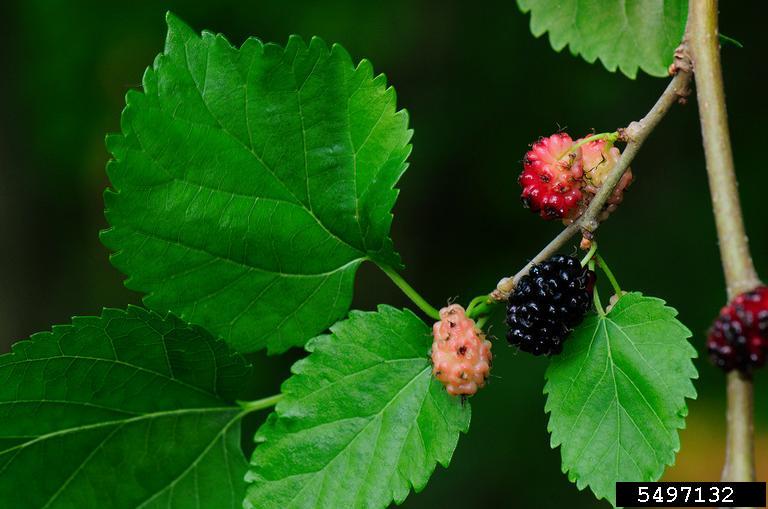
by Larry Williams | Jul 7, 2015
There are a number of plants in my landscape that bring back fond memories – plants that I propagated.
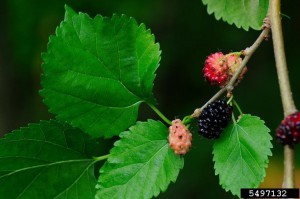
Red Mulberry. Photo credit: Vern Williams, Indiana University, bugwood.org.
There’s a mulberry tree in my backyard that I rooted years ago. I took the cuttings from an old mulberry tree in my hometown. As a boy, I climbed the tree, got in trouble once for coming home with mulberry stains on my clothes. I liked the berries and still do. I have good childhood memories about the tree.
About twenty years ago I visited the property adjacent to my childhood home. The tree was still there. It was during mulberry season. I enjoyed a few mulberries. I took about eight or ten cuttings from the tree. About a year after my visit, the property sold. The new owner bulldozed the tree.
But because of the cuttings that I rooted, the tree still lives and not just in my memory. The trees produced by those cuttings are genetically the same as the parent tree. Essentially, they are clones. The one in my backyard produces mulberries each year.
You too can propagate memories. Not all plants can be propagated from cuttings but many can be. Sometimes trial and error is necessary to learn proper timing in taking cuttings. But most reliable references will provide the time of year to take cuttings based on the plant species.
Stem cuttings should be removed from the parent plant with a clean, sharp knife or pruner. Ideally your cutting should be 4-6 inches in length and not much thicker than a pencil in diameter.
Take the bottom two-thirds of leaves off on each cutting. The cuttings should be stuck upright in a propagation medium. I usually use a good quality potting mix and mix in a little course sand or perlite for better drainage. The cuttings should be inserted deep enough to hold them upright, usually ½ to 1 inch.
To help promote rooting of moderate to difficult to root plants, wound the cuttings by scraping the lower ½ to 1 inch of the stem with a clean, sharp knife. The scrape should remove the bark or “skin.” Then dip the cutting in a rooting hormone covering the scrape with the rooting powder prior to inserting the cutting into the rooting medium.
I usually use a four inch pot, gallon size pot or bedding plant flat with drainage holes as a rooting container. I may stick as many as ten stem cuttings in a gallon size pot. I place the container of cuttings in a shady location outdoors and keep it moist. The cuttings should produce roots in two to sixteen weeks, depending upon plant species and the environment.
After the cuttings have rooted, carefully remove them and individually plant each rooted cutting in its own four inch to one gallon size pot. Keep the potting medium moist but not soggy. After the roots adequately fill the pot, the plant should be strong enough to be planted in the ground.
As your rooted cuttings grow, hopefully they will provide fond memories.
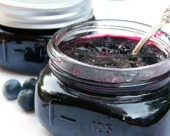
by Matthew Orwat | Apr 21, 2015

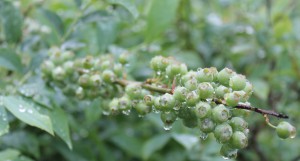 In all North Florida Counties, blueberry jam, blueberry cobbler and fresh blueberries seem to be a staple. This is because there are many home gardeners are able to consistently grow a top quality product. This year blueberries are very large already on plants throughout the panhandle! The increased size may be indicating earlier maturity than in the previous few years.
In all North Florida Counties, blueberry jam, blueberry cobbler and fresh blueberries seem to be a staple. This is because there are many home gardeners are able to consistently grow a top quality product. This year blueberries are very large already on plants throughout the panhandle! The increased size may be indicating earlier maturity than in the previous few years.
Backyard gardeners also desire to grow the same type of blueberries grown by local farmers but sometimes struggle to find the correct type. Vaccinium ashei (commonly known as rabbit-eye blueberry) is a species of blueberry native to Florida and adapted to the late frosts we sometimes get in Northwest Florida during the months of February and March. It is recommended that this species be grown in this area, not its sister species the Southern Highbush, Vaccinium darrowii. There are several dwarf cultivars of Vaccinium darrowii that can be used to great effect in the landscape, but will not produce a noticeable crop of fruit most years.
The rabbit-eye blueberry is a deciduous shrub growing to 3 to 6 feet tall and with up to a 3 foot spread. The leaves start out red-bronze that turn dark-green when fully developed. It has small, white bell-shaped flowers. It produces 5 mm diameter fruit, dark blue to black, with a pale gray wax coating.
Rabbet-eyes are self-infertile, meaning that they must have two or more varieties to pollinate each other. Therefore it is advisable to plant two or more cultivars close together to ensure complete fruit set. Recommended cultivars for our area include, ‘Brightwell’,’ Climax’, ‘Beckyblue’, ‘Tif-Blue’, Powderblue, ‘Woodard’, ‘Chaucer’ and ‘Bluegem’. Old, local plants can be found in gardens and in the woods, due to the fact that the WPA planted them under pines in the 1930s. These can easily be propagated by cuttings or by nicking and burying a lax stem under soil for a few month. Once the stem forms roots, it can be severed from the mother plant and transplanted.
Blueberries grow best on acid soil at a pH of 4.0 to 5.2. Few pests and diseases bother them, with the exception of scale, whitefly and mealybug. These are controlled with a combination of dormant oil sprays, and insecticidal soap.
Blueberries enjoy soil rich in organic matter and benefit to liberal applications of pine bark mulch. Their roots are fairly weak and should not be planted near turf or other weeds which may out-compete them in the race for water and nutrients. Mulching eliminates this grass and weed competition. In soil where organic matter is very low, such as in coastal sand hills, gardeners should grow blueberries in 2 foot deep trenches filled with rotting pine bark. Blueberries enjoy being spoon fed fertilizer, since heavy fertilizer doses stop fruit set and may damage fragile root systems.
When planting, it is advisable to not include fertilizer in the planting hole. “Blueberry Special” fertilizer mixes are available which are made up of ammoniacal or urea based nitrogen sources, with an analysis of 12-4-8 and 2% magnesium. This mixture is available at many local feed and garden stores. New plants should get one ounce per application in April, June, August and October. 2 year plants should receive 2 ounces per application and older plants should receive 3 ounces per application. Fertilizer should be spread in a circle 2-4 feet in diameter around the plant for optimal root uptake. It does no good to just pour the fertilizer at the plant base, since feeder root are further out from the plant.
Feel free to contact your UF IFAS extension agent for more information about blueberry cultivation
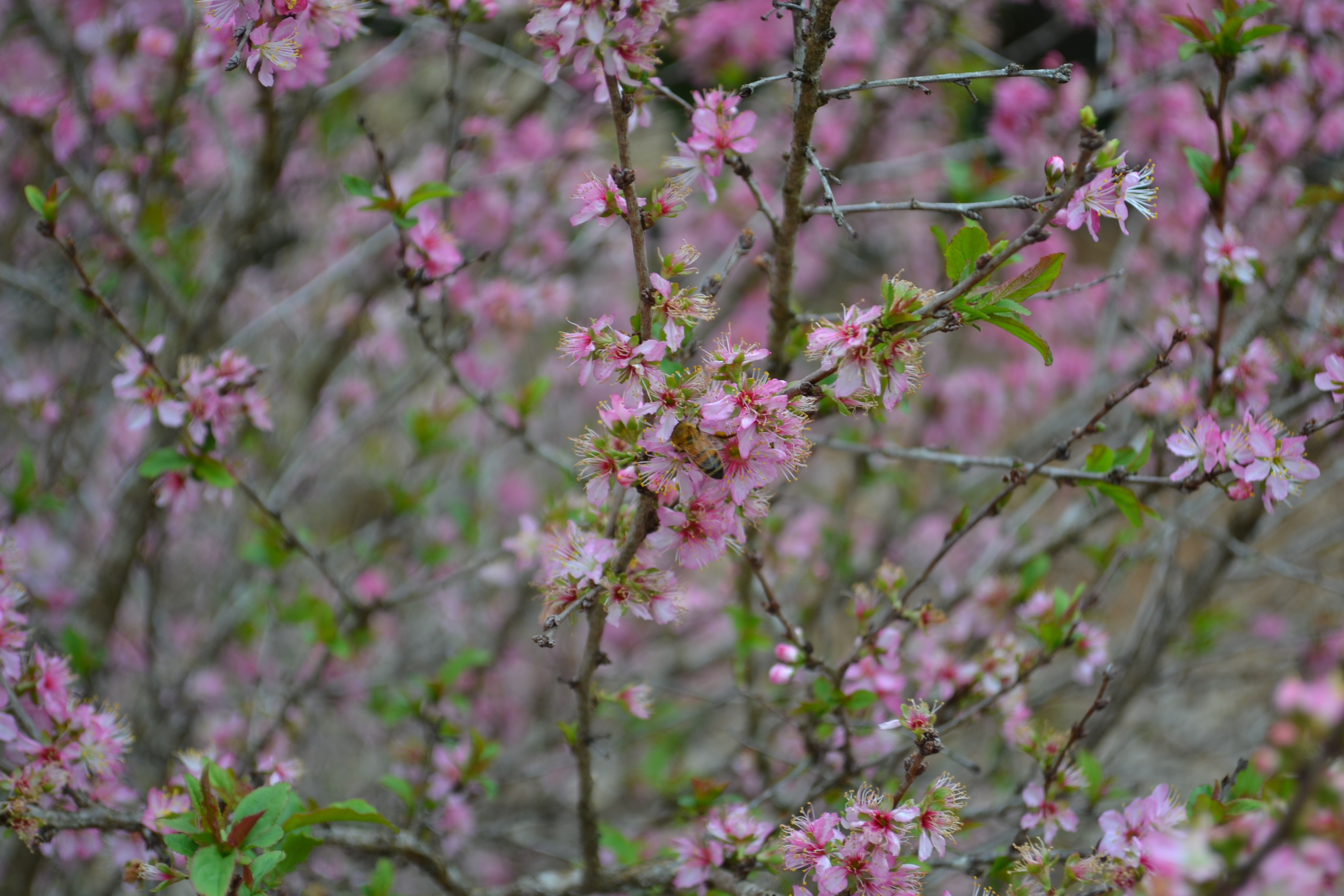
by Beth Bolles | Mar 10, 2015
Although we are not able to grow edible cherry trees in more southern climates, there are a few ornamental relatives of the cherry that are worth adding to the landscape. The Bush cherry, Prunus jacquemontii, is an attractive deciduous shrub that is a highlight with pink blooms in late winter. Flowers provide an early nectar source to bees.
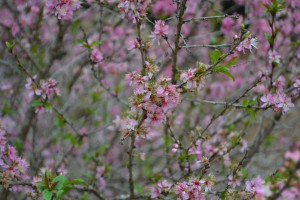
Bees are actively visiting flowers.
Plant the bush cherry is an area that receives sunlight and allows for the rounded shrub to grow about 5 feet by 5 feet. Plants like well-drained soil but benefit from some moisture during the growing season. Small berries serve as a food source for wildlife and can be used in jellies and jams. Leaves turn yellow in the fall before dropping. Plants are generally low maintenance and certainly brighten winter days. 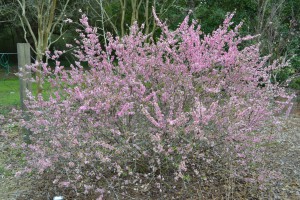
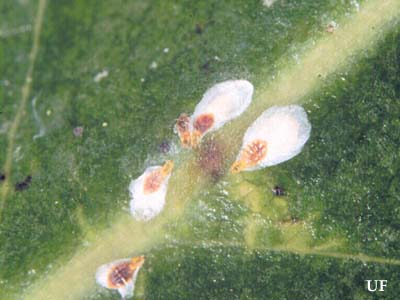
by Matthew Orwat | Jan 27, 2015

The magnolia white scale, Phenacaspis cockerelli, is also called false oleander scale. Image credit http://entomology.ifas.ufl.edu/creatures/orn/scales/false_oleander_scale.htm
Many fruit and ornamental shrubs and trees suffer from scale insects throughout the year. Most of the time home gardeners notice these insects in the spring or summer, because their exudate is the primary substrate for sooty mold growth. Although it seems counter-intuitive, the best time to control scale insects is in late winter. This can be achieved with one or two applications of horticultural oil, often called “dormant oil” in late January and early February.
Horticultural oil has been in use for well over one hundred years. While first only available in dormant oil formulations, it is now available in several types that allow for near year round application. Winter or “dormant” oils are heavier in weight, so they take longer to dissipate. Therefore, they cover pests for longer periods of time and are highly effective. All-season oils are purer, lighter and mixed with an emulsifier. This ensures that it will mix with water well and not damage the plant when exposed to warm, high-light conditions.
Horticultural oils are effective on soft-bodied insects and their eggs. Although scale insects often have a hard outer covering, they are considered soft-bodied. In addition to scale, mealybugs, aphids and spider mites are affected. These oils work primarily by smothering the insect and/or their eggs. Thus when oils are used, they block the insect’s ability to breathe.
Dormant oil is not a cure-all. It does not last very long, therefore the insect must be present for it to work. Additionally, it may kill beneficial insect eggs, so only use when a pest is present and do not apply to areas where infestations are not known. Make sure to cover the underside of the leaves and stems with spray.
Before applying dormant oils read the product label carefully. Any sensitive plants will be listed and temperature limitations will be noted.
Dormant oil is commonly used to control pests on these plants:
- Fruit trees in the Rosaceae (Pear, Apple, Peach, Plum, Nectarine, Blackberry)
- Roses
- Camellia (when not in bloom)
- Magnolia
- Gardenia
- Blueberry
- Crapemyrtle
- Dogwood
- Citrus
- Many others
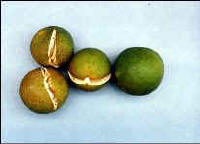
by Roy Carter | Oct 28, 2014

Split citrus fruit. Image credit UF / IFAS
Citrus trees require a lot of care and attention to produce good quality fruit, yet even the most careful gardeners may run into the problem of split-fruit on their citrus trees. Split-fruit is a condition which strikes citrus trees in September and October and can wipe out a hundred or more fruit on a single tree. Researchers at the University of Florida have been studying fruit splitting for many years. Clear cut causes or solutions have not been found. My information on fruit splitting was provided by Extension Fruit Crop Specialist, Dr. Pete Andersen with IFAS located at Quincy, North Florida Research and Education Center.
Researchers have found that certain varieties of citrus tend to split more often than other. “Sweet Oranges” Tangelos” and certain varieties of Satsuma’s tend to split more than citrus which is not sweet. Grapefruit and acid fruits, such as lemons and limes rarely split.
The condition is known to be more common in seedlings and young trees than in older, more settled trees. However, split-fruit can be a very serious problem when it occurs on mature trees, because they usually have more fruit to lose.
Another condition which will cause fruit to split is insufficient copper in the soil. This used to be a much greater problem than it is today, due to the wide-spread use of copper in most fertilizer and spray programs. Potassium deficiency results in small, firm fruit with thin peels and increased fruit splitting. However, added potassium doesn’t correct splitting related to citrus varieties.
The most commonly held belief is that fruit splitting is caused by climatic conditions, since it only seems to occur at one time of the year. During the late summer and high humidity, followed by periods of drought. After a series of heavy rains, the trees absorb a great deal of moisture and force it into the fruit. Since the fruit is near maturity, the rind becomes less pliable and can’t expand rapidly enough to absorb the great volume of water from the trees. As a result the fruit splits.
Despite these findings, there are numerous cases of fruit splitting that doesn’t appear to be related to any of the above conditions. When the cause of the split is not fully understood, there is not absolute method of control. Also, there is no way to stop fruit splitting while it is occurring. The problem must be prevented before it starts. Attempts to control splitting through irrigation practices, fertilization and growth regulators have met with some success.
Fertilizer and irrigation practices won’t cure splitting, but may help to avoid large increase in the number of split fruit. In addition, growth regulators are available which can thicken the peel of the orange. Thicker peels have been found to split much less often that the thinner peels, due to their ability to withstand extra water pressure during the critical moths of the year.
If fruit splitting is a problem this year follow a recommended fertilizer program next year. This will insure a good supply of minor nutrients, especially copper. Make sure to keep the trees well watered during the dry periods of late summer and early fall. This will keep the fruit from swelling too rapidly, and splitting as a result.

by Matthew Orwat | Sep 16, 2014
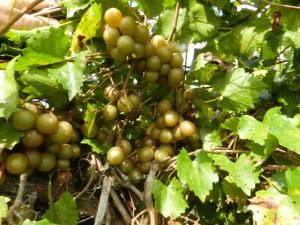
Prolific producing muscadine cultivar ‘Granny Val’ – Image Credit Dr. Peter C. Andersen
Mother always said “never be late” but in the case of certain muscadine (Vitis rotundifolia) cultivars, it’s good to be late.
Although muscadine harvest can begin as early as July, gardeners with late bearing muscadines are still reaping the benefits of fruit harvest and may until early October.
Northwest Florida gardeners often grow muscadines as a substitute for traditional grape (Vitis vinifera) cultivars such as ‘Concord’ or ‘Thompson’s Seedless’, since they are prone to Pierce’s Disease. In fact, muscadines are native to the southwest USA and resistant to a variety of insect and disease pests, so much so that they can be grown in the home garden without the use of insecticides or pesticides.
An additional advantage of gardening with muscadines is that they can easily be asexually propagated. To mimic the natural asexual propagation of wild muscadines, home gardeners may use the pegging method. Pegging entails wounding the branch in several locations, then burying the wounded section of the branch in moist soil while leaving the shoot tip exposed. If this is done in the late spring or summer, roots should form from the main branch in about a month. After roots are confirmed, the connection with the mother plant can be cut.
Planting time for muscadines depends on the type of plant purchased. If gardeners want to plant bare root vines, they should plant them between December and January, but containerized plants can be planted any time.
Before muscadines are planted, soil tests should be performed to determine pH. Muscadines can be grown in the pH range of 5.5 to 7.0, with the optimal level between 6.0-6.5. Since many soils in northwest Florida are highly acidic, tests should be done at least 3 months before planting. This will allow the addition of an optimal lime source Dolomite, which takes 3 months to raise the pH but also adds magnesium to the soil.
If this article prompts the reader to plant muscadines, refer to HS # 753 “The Muscadine Grape” for information about establishment, irrigation and fertilization.
Here is a list of recommended late bearing cultivars to look for when selecting plants.
-
Big Red
-
Delight
-
Doreen
-
Farrer
-
Granny Val
-
Late Fry
-
Nesbitt
-
Polyanna
-
Supreme
-
Pineapple












